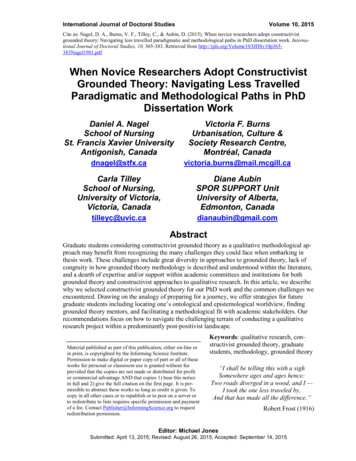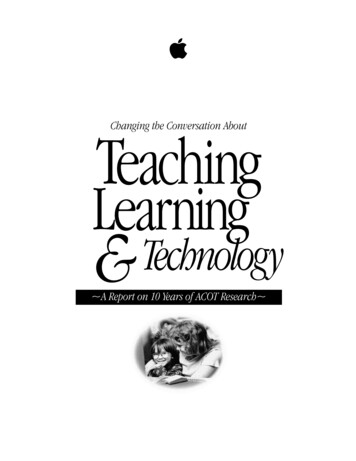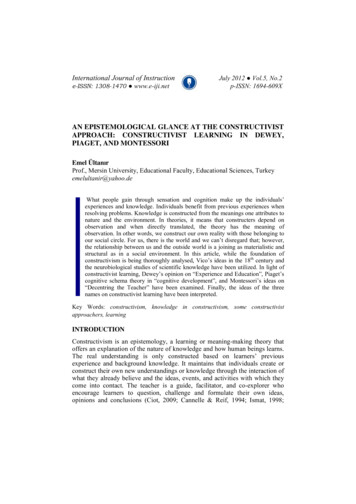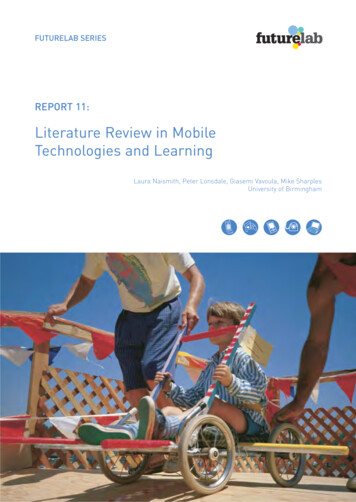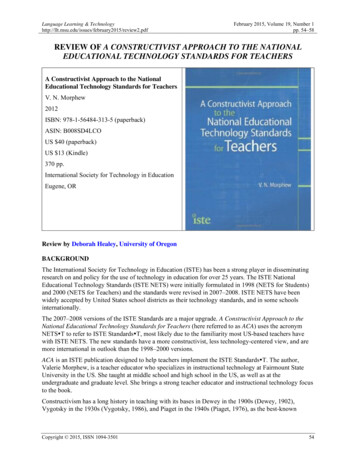
Transcription
Language Learning & eview2.pdfFebruary 2015, Volume 19, Number 1pp. 54–58REVIEW OF A CONSTRUCTIVIST APPROACH TO THE NATIONALEDUCATIONAL TECHNOLOGY STANDARDS FOR TEACHERSA Constructivist Approach to the NationalEducational Technology Standards for TeachersV. N. Morphew2012ISBN: 978-1-56484-313-5 (paperback)ASIN: B008SD4LCOUS 40 (paperback)US 13 (Kindle)370 pp.International Society for Technology in EducationEugene, ORReview by Deborah Healey, University of OregonBACKGROUNDThe International Society for Technology in Education (ISTE) has been a strong player in disseminatingresearch on and policy for the use of technology in education for over 25 years. The ISTE NationalEducational Technology Standards (ISTE NETS) were initially formulated in 1998 (NETS for Students)and 2000 (NETS for Teachers) and the standards were revised in 2007–2008. ISTE NETS have beenwidely accepted by United States school districts as their technology standards, and in some schoolsinternationally.The 2007–2008 versions of the ISTE Standards are a major upgrade. A Constructivist Approach to theNational Educational Technology Standards for Teachers (here referred to as ACA) uses the acronymNETS T to refer to ISTE Standards T, most likely due to the familiarity most US-based teachers havewith ISTE NETS. The new standards have a more constructivist, less technology-centered view, and aremore international in outlook than the 1998–2000 versions.ACA is an ISTE publication designed to help teachers implement the ISTE Standards T. The author,Valerie Morphew, is a teacher educator who specializes in instructional technology at Fairmount StateUniversity in the US. She taught at middle school and high school in the US, as well as at theundergraduate and graduate level. She brings a strong teacher educator and instructional technology focusto the book.Constructivism has a long history in teaching with its bases in Dewey in the 1900s (Dewey, 1902),Vygotsky in the 1930s (Vygotsky, 1986), and Piaget in the 1940s (Piaget, 1976), as the best-knownCopyright 2015, ISSN 1094-350154
Deborah HealeyReview of Constructivist Approach to NETS for Teacherswriters. ACA gives three major elements of a constructivist learning as a) meaningful experiences, b)interactions, and c) prior knowledge (p. xiii). These serve as points of reference for suggested activitiesrelated to each of the standards.ORGANIZATIONACA is organized by standards, with one chapter for each standard, plus an introduction and a conclusion.Each chapter in ACA starts with the standard in brief, a list of the performance indicators, a bit ofbackground information about the standard, then the learning outcomes for the chapter. The chapter isthen divided into the four performance indicators for that standard. With each performance indicatorcomes a lengthy explanation of the relationship between that performance indicator, theory, and practice.The earlier chapters and performance indicators have more general explanatory material aboutconstructivism and technology use than later chapters. With each performance indicator come suggestedactivities and technologies that can be used to meet that performance indicator. Also included in eachsection are “In your experience,” where readers are encouraged to respond to a question based on theperformance indicator, using their previous experience; “Explorations,” where readers have five or moresuggested activities to build their skill in the areas referenced in that section; and “Review,” which servesas a brief recap of the information in that section. Figures and tables provide a visual representation ofinformation, although some figures add little to the content. Resource Lists interspersed throughout thechapters offer related websites. The end of each chapter has a summary of the chapter, endnotes, andreferences for the chapter.COMMENTSThis is a very useful book for those new to the ISTE Standards, constructivist teaching, and appropriateuse of technology in teaching. The reflective questions and activities in the Explorations for eachperformance indicator serve to strengthen understanding of the core concepts in that section. For example,performance indicator t1a for Standard 1 focuses on facilitating and inspiring student creativity. One ofthe Explorations is to “Create a graphic organizer that represents your understanding of creativity and thecreative process.” (p. 26). If the chapters had been built around the Explorations rather than the other wayaround, the organization may have felt tighter and the focus on constructivism clearer.General background information is packed into each section, especially in the first two chapters. Bloom’srevised taxonomy (Anderson & Krathwohl, 2001) and Gardner’s Multiple Intelligence theory (Gardner,1999) are explained and used as the basis of Standard 1’s creativity focus. A description of researchmethods in general, steps for sourcing technology, and differentiated instruction are included as part ofStandard 2: “Design and develop digital-age learning experiences and assessments.” The addedbackground information can make the organization hard to follow and sometimes also results inirrelevancies. For example, a discussion of performance indicator t1b about exploring real-world issuesincluded Ninteno’s baseball wii game. It is a good example of turning a non-computer game into acomputer game, but hardly related to a real-world problem.As one of the members of TESOL’s Technology Standards Task Force and a co-author of TESOL’sTechnology Standards: Description, Implementation, Integration, I was very interested in reading moreabout the revised ISTE standards and how they can be applied in a constructivist way. The work of theTESOL Task Force was informed by the 1998 ISTE NETS for Students (ISTE, 1998) and the 2000 ISTENETS for Teachers (ISTE, 2000), as well as the United Nations Education, Scientific and CulturalOrganization’s (UNESCO’s) Information and Communication Technologies Competency Standards forTeachers (UNESCO, 2008). Both the ISTE and the UNESCO standards assume a centralized system ofeducation and age-appropriate literacy. These are not universally true in English language teachingsettings. In developing the TESOL Technology Standards, the Task Force examined ways that differentregions of the world implement technology in teaching. The result was an emphasis in the TESOLLanguage Learning & Technology55
Deborah HealeyReview of Constructivist Approach to NETS for Teachersstandards on “available technology” and locally appropriate practice. The TESOL standards includevignettes that show implementation of the standards and performance indicators in high-, medium-, andlow-resource contexts internationally, and in a variety of teaching settings: with children, teens, andadults; with learners at a range of literacy and English proficiency; for a variety of purposes.I was quite happy to see the emphasis on transfer in the new Standard 3’s performance indicator t3a,“Demonstrate fluency in technology systems and the transfer of current knowledge to new technologiesand situations.” The ability to take prior knowledge and adapt it to a new situation is really the heart ofbeing an effective technology-using teacher in a world of constantly-changing technologies.Also heartening was Standard 5’s performance indicator t5b: “Encourage leadership by demonstrating avision of technology infusion, participating in shared decision making and community building, anddeveloping the leadership and technology skills of others.” As in the TESOL Technology Standards,teachers are urged to make technology an integrated part of teaching, and administrators are encouragedto provide training and resources for teachers so that they can use technology effectively. This is certainlyconstructivist in its community building emphasis. Infused technology is also a hallmark of “normalizedCALL” (Bax, 2003).The revised ISTE standards are certainly appropriate to current teaching, including constructivistlanguage teaching. However, I was hoping to see much more of an international perspective both in thenew standards and in ISTE publications about them. In many places around the world, access totechnology resources is limited. The resource lists and examples of technology tools in the text do notmention whether they are commercial or free resources. This is an important distinction for many teacherswithout a technology budget. Listing that information would also help the author and editor be awarewhen a resource list consists almost entirely of commercial products, and non-commercial options couldbe added before publication.Standard 3 calls on teachers to act in ways “representative of an innovative professional in a global anddigital society.” Both performance indicator 3b and 3c emphasize collaboration and communication withdigital tools. ACA’s only concern in communicating with parents is whether or not they have Internetaccess. This misses a substantial concern about language, especially when the parents speak a languagethat the teacher does not. Multilingual environments are the norm in a global society.Standard 4 makes reference to global societal issues and responsibilities, which could have enabled somediscussion of international concerns related to technology use. The discussion about copyright is USbased, with references to US copyright law. A few resources that do not reference the US should havebeen included, such as RightsDirect and the World Intellectual Property Organization. It would also behelpful to note that many parts of the world do not see plagiarism the way that the US does.Performance indicator 4d asks teachers to: “Develop and model cultural understanding and globalawareness by engaging with colleagues and students of other cultures using digital-age communicationand collaboration tools.” The explanation of collaboration tools and projects offers information aboutresources that have a global reach. Global SchoolNet is a good choice; sadly, ThinkQuest is not longeravailable. A missing but worthwhile resource is TakingITGlobal, a portal for international projects andcollaborations with a focus on teens and young adults. The Explorations are interesting and useful, butthey assume that teachers have a basic knowledge of what “global awareness” is and how to promote it.The overall impression given in this section is that use of these resources will automatically mean globalawareness and understanding. Students and teachers still need to know how to communicate effectivelywith those who are culturally different and who may be located halfway around the world.Of greatest concern are two related areas. One is the general tone of the book. Technology is almostalways seen as a solution. In Chapter 5, teachers are encouraged to participate in lifelong learning in anumber of ways, including formal learning with distance education and teacher-to-teacher learning.Language Learning & Technology56
Deborah HealeyReview of Constructivist Approach to NETS for TeachersSecond Life is used as an example of a virtual world for learning. Consistent with the rest of the book,this section provides advantages of learning in these different modes without mentioning potentialdrawbacks. Distance learning is a very good approach for autonomous learners, for example, but does notwork well for those who need a more high-touch, personal environment. Virtual worlds can be wonderfulfor those who know where to go and what to do. Newcomers without a guide to the virtual world mayfind physical text-based information more accessible.In keeping with the view that technology is a solution, the problems that technology can cause are rarelymentioned. This plays into the myth that all technology change is progress, and all progress is positive.We know that there are large risks created by technology, including loss of privacy, misrepresentation andtheft of personal information and data, dissemination of harmful or hateful information to a broadaudience, and the ability to make life substantially worse for a very large number of people quickly due tothe links among computer-based systems. For teachers, technology does not always work seamlessly, andcreating a Plan B for technology failure takes additional time.The other area of concern is the frequent focus on technology and technology resources rather than on ateacher’s use of the technology. For example, the author states, “Creating rubrics is easy if technology isused” (p. 121). Technology does not create good rubrics; a knowledgeable teacher creates good rubricsthat fit specific classroom objectives, and then uses technology to help with formatting the rubricsappropriately.It is very easy for all of us as technology-using educators to slip into a technology-focused perspective. Atthis point in time, however, we should no longer be trying to encourage teachers to use technology. Ourfocus instead should be on giving teachers helpful approaches to wise use of technology. Much of ACAdoes just that. Those who work through the reflections and the explorations will have an opportunity tobuild expertise in making decisions about when, where, and how to use technology, both appropriatelyand constructively.ABOUT THE AUTHORDr. Deborah Healey has taught English and trained teachers for over 35 years. She currently offers onlinecourses for teachers internationally through the University of Oregon’s American English Institute andteaches in the University of Oregon’s Master’s program in Linguistics. She has presented extensivelythroughout the Middle East, North Africa, Asia, and Latin America on technology in education. She is aco-author of TESOL Technology Standards: Description, Implementation, Integration and lead linguistfor the ELT game, Trace Effects. Her Ph.D. is in computers in education.E-mail: dhealey@uoregon.eduREFERENCESAnderson, L. W., & Krathwohl, D. R. (Eds.). (2001). A taxonomy for learning, teaching, and assessing: Arevision of Bloom’s taxonomy of educational objectives. New York, NY: Addison Wesley Longman.Bax. S. (2003). CALL – past, present, and future. System, 31, 13–28.Dewey, J. (1902). The child and the curriculum. [out of print; free ebook]. Retrieved fromhttp://www.gutenberg.org/ebooks/29259.Gardner, H. (1999). Intelligence reframed: Multiple intelligences for the 21st century. New York, NY:Basic Books.Language Learning & Technology57
Deborah HealeyReview of Constructivist Approach to NETS for TeachersHealey, D., Hanson-Smith, E., Hubbard, P., Ioannou-Georgiou, S., Kessler, G., & Ware, P. (2011).TESOL technology standards: Description, implementation, integration. Alexandria, VA: TESOL.ISTE. (1998). National educational technology standards for students. Eugene, OR: ISTE.ISTE. (2000). National educational technology standards for teachers. Eugene, OR: ISTE.Piaget, J. (1976). To understand is to invent: The future of education. G-A Roberts (Trans.) Où val'éducation?, 1948. New York, NY: Penguin Books. Retrieved . (2008). ICT competency standards for teachers: Competency standards module. Paris, France:UNESCO.Vygotsky, L. (1986). Thought and language. A. Kozulin (Trans. & Ed.). Cambridge, MA: MIT Press.(original work published 1934)Language Learning & Technology58
Educational Technology Standards (ISTE NETS) were initially formulated in 1998 (NETS for Students) and 2000 (NETS for Teachers) and the standards were revised in 2007-2008. ISTE NETS have been widely accepted by United States school districts as their technology standards, and in some schools internationally.
